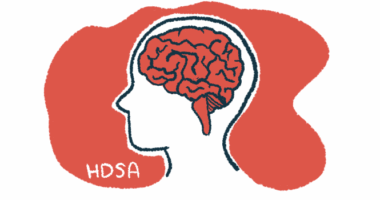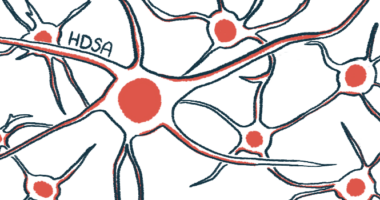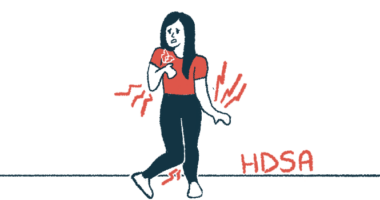Alprazolam for Huntington’s disease
Last updated July 17, 2024, by Marisa Wexler, MS

What is alprazolam for Huntington’s disease?
Alprazolam is an antianxiety, or anxiolytic, oral medication that’s approved in the U.S. for adults with acute episodes of generalized anxiety disorder and those with a panic disorder, characterized by frequent and unexpected panic attacks.
In people with Huntington’s disease, the therapy may be prescribed to treat anxiety, and used off-label to help manage agitation and potentially irritability, as well as other symptoms of the neurodegenerative condition.
Alprazolam was originally developed by Upjohn (now part of Pfizer), and is marketed under the brand name Xanax for its oral tablet formulation, and as Xanax XR for its extended-release tablet formulation. Generic versions of these formulations are also available in the U.S.
An orally disintegrating tablet formulation of alprazolam — meaning the tablet dissolves quickly in the mouth — was originally sold under the brand name Niravan. However, it was later discontinued in the U.S., and is now available only in a generic version. The therapy also is available in a concentrated oral solution formulation.
Therapy snapshot
| Treatment name: | Alprazolam |
| Administration: | Oral tablets or solution |
| Usage: | Used in Huntington’s to treat anxiety and off-label for agitation |
How does alprazolam work?
Huntington’s is an inherited, progressive disease marked by motor problems, cognitive impairment, and psychiatric issues such as depression, anxiety, irritability, and agitation.
In the U.S., alprazolam is the most commonly prescribed psychotropic medication — a therapy designed to change a person’s mental state. Alprazolam belongs to a class of psychotropic medications called benzodiazepines, which work by binding to a cell surface protein called the GABA-A receptor.
GABA-A is a neurotransmitter, or a signaling molecule that nerve cells use to communicate with each other. It typically acts to suppress the activity of nerves by binding to its receptor proteins at the surface of those nerves.
By binding to the GABA-A receptor, alprazolam makes GABA-A more prone to bind to its receptor, boosting its suppressive effects on the nervous system. This is thought to be the main mechanism by which the therapy exerts its psychotropic effects that may help ease psychiatric problems in Huntington’s patients.
How is alprazolam administered?
Several different forms of aripiprazole are available. These include:
- oral tablets and orally disintegrating tablets, available at doses of 0.25 mg, 0.5 mg, 1 mg, and 2 mg
- extended-release tablets, available at doses of 0.5 mg, 1 mg, 2 mg, and 3 mg
- a concentrated solution, given via an oral syringe containing 0.25 mg, 0.5 mg, 0.75 mg, or 1 mg of the therapy.
The oral tablets, orally disintegrating tablets, and concentrated solution usually are taken 2-4 times a day. The extended-release tablet is taken once daily, usually in the morning.
Under its approval for generalized anxiety and panic disorders, the recommended starting dose of alprazolam’s oral tablets and oral concentration is 0.25 to 0.5 mg, taken three times per day. The dose may then be increased every three to four days based on how the patient responds.
The maximum daily recommended dose is 4 mg for anxiety disorder and up to 10 mg for panic disorder — but patients on doses higher than 4 mg per day should be regularly reassessed to see if a reduction in dose is feasible.
For extended-release tablets, the recommended starting dose is 0.5 mg to 1 mg, once per day, which can be increased to a total daily dose of 3 mg to 6 mg. Doses up to 10 mg have been used in people with panic disorder. Those switching from instant-release tablets to extended-release tablets can do so by maintaining their total daily dose.
Reduced starting doses or dosing frequency is recommended for geriatric patients, those with liver impairment, and those taking certain medications.
If patients need to stop taking alprazolam, the therapy should be slowly tapered off by no more than 0.5 mg every three days. This is done to minimize the risk of withdrawal reactions; if these are detected, it may be necessary to slow the taper or increase the dosage to the previous level.
Common side effects of alprazolam
In clinical trials involving people with anxiety or panic disorders, but not Huntington’s specifically, the most common side effects of alprazolam include:
- drowsiness
- impaired coordination
- constipation
- slurred or slowed speech, known as dysarthria
- changes in sex drive or ability
- low blood pressure, called hypotension.
Risks from use in combination with opioids
The prescribing information for Alprazolam carries a boxed warning against the therapy’s use in combination with opioids. That warning notes that such use can result in profound sedation, breathing problems, coma, and death.
Alprazolam should only be given in combination with opioids if other treatment options are not working. In such cases, the lowest dose and shortest treatment durations should be used, and patients and caregivers should be cautioned about the risks of sedation and breathing difficulties.
Abuse, misuse, and addiction
The therapy’s boxed warning also notes that benzodiazepines, including alprazolam, carry risks for abuse and addiction, which can lead to overdose or death. Before receiving alprazolam, and regularly throughout treatment, patients should be counseled about this possible risk, and monitored for potential signs of abuse and addiction.
Patients who show signs of substance abuse disorder should be referred as soon as possible for appropriate treatment. Due to the addiction risk, alprazolam should be prescribed at the lowest effective dose, and it should be avoided in combination with other drugs that have the potential for abuse.
Dependence and withdrawal
Continuous use of alprazolam can lead to dependence, sometimes called physical addiction, in which the body relies on the drug to function normally. The risk for dependence tends to be greater when taking the drug at higher doses and/or for a longer periods of time.
As such, suddenly stopping alprazolam treatment can lead to symptoms of withdrawal, including seizures, increased senses, changes in smell, concentration problems, muscle cramps or twitching, diarrhea, blurry vision, reduced appetite, and weight loss. In some cases, withdrawal symptoms can last more than a year, and there have been cases of serious and fatal withdrawal reactions, to include seizures.
To minimize the risk of withdrawal, alprazolam should always be gradually tapered off if the therapy needs to be stopped.
Caution with driving, machinery, and alcohol
Given that alprazolam is a depressant, meaning it broadly decreases neurological activity within the brain, patients on the therapy should refrain from potentially dangerous activities like driving and operating machinery until they know how it affects them.
For the same reason, patients should be cautioned about the potential for dangerous interactions when using alprazolam with other depressants, including alcohol.
Use with other drugs
Alprazolam is contraindicated for use in combination with medications that are strong suppressors of the liver enzyme CYP3A. These include the antidepressants nefazodone and fluvoxamine; a medication called cimetidine that’s used to manage heartburn and stomach ulcers; and a class of medicines known as azole antifungals, which are used to treat certain fungal infections.
The therapy may be used in combination with one specific CYP3A inhibitor called ritonavir, an antiviral medicine used to treat HIV, though dose adjustments are necessary.
Considerations for patients with depression
Benzodiazepines such as alprazolam may worsen depression, a mental health condition that is common among people with Huntington’s. There have been reports of patients with depression experiencing other mood changes, such as mania, while taking alprazolam. Patients with depression should have their mental health checked regularly while taking the therapy.
Risk in patients with lung disease
There have been reports of death shortly after starting alprazolam in patients with severe lung disease. Those with impaired lung function should be closely monitored when starting alprazolam, and the therapy should be discontinued at the first sign of worsened lung function.
Use in pregnancy and breastfeeding
A U.S. registry called the National Pregnancy Registry for Psychiatric Medications is collecting data from pregnancies exposed to psychiatric medications, including alprazolam. The registry can be contacted online or by phone at 1-866-961-2388.
Available data do not indicate a substantial increase in the risk of major birth defects when alprazolam is used during pregnancy. However, babies exposed to alprazolam during the third trimester of pregnancy may experience sedation, breathing problems, and low muscle tone, and/or symptoms of withdrawal such as irritability, restlessness, inconsolable crying, and difficulty feeding). Given these potential reactions, babies born after such exposure should be closely monitored, with appropriate supportive care given as needed.
Alprazolam is present in human breast milk, and there are reports of infants experiencing sedation, poor feeding, and reduced weight gain when the therapy is used during breastfeeding. As such, breastfeeding is not recommended while on alprazolam.
Huntington’s Disease News is strictly a news and information website about the disease. It does not provide medical advice, diagnosis or treatment. This content is not intended to be a substitute for professional medical advice, diagnosis, or treatment. Always seek the advice of your physician or other qualified health provider with any questions you may have regarding a medical condition. Never disregard professional medical advice or delay in seeking it because of something you have read on this website.
Recent Posts
- HDSA 2025: Speech therapy can help Huntington’s disease patients
- HDSA 2025: Early planning key for navigating care over time
- HDSA 2025: Psychedelic compound eases depression in mice
- HDSA 2025: Support can help combat Huntington’s disease stigma
- HDSA 2025: Nonprofit pushes to protect Medicaid, advance bills
- Chasing windmills: Hope in the face of Huntington’s disease
- My neuropsychiatrist shares her perspective on Huntington’s
- HDSA 2025: Community gathers for 40th annual convention
- First Huntington’s patient dosed in Phase 2/3 trial testing SKY-0515
- Embracing mindfulness and meditation in life with Huntington’s
Related articles






